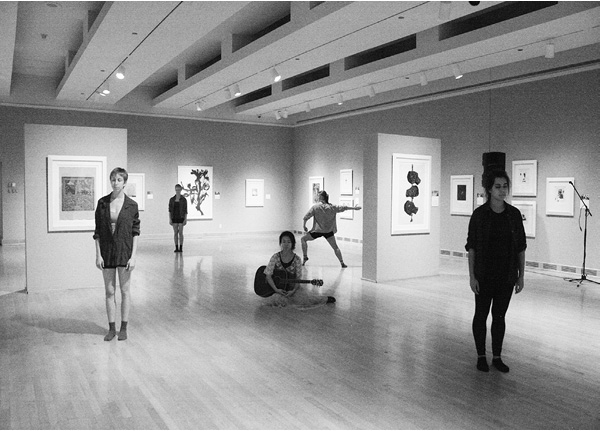
WAITING FOR A PASSENGER / SHIP TO GO TO SEA
first performed on January 20, 2015
Arizona State University Art Museum, Tempe, AZ
performed four times in 2015
IN KYUNG LEE
Allyson Yoder, Angel Crissman, Eleanor Hanafin, Lacee Garcia
Brooklyn, NY
inkyunglee.me
WAITING FOR A PASSENGER / SHIP TO GO TO SEA
IN KYUNG LEE
I wanted to create poetry through bodies. I wanted to make prayer in motion. I wanted to trust in feelings and the fleetingness of truth, and craft something that could surpass seeing. Peggy Phelan says, “To live for a love whose goal is to share the Impossible is both a humbling project and an exceedingly ambitious one, for it seeks to find connection only in that which is no longer there. Memory. Sight. Love.” It was my attempt to love through the work.
The performance was about an hour in length. In the first half, five dancers move through rigorous and exacting structure—consisting of geometrical spatial patterns, cyclical counting systems (4-4-3-6-6-3-3-4-1-repeat) and minimalistic movement vocabulary—that develops over time. One of the dancers continuously jumps in a constant speed to provide the beat for the other dancers to count. The jumper’s breath becomes audibly heavier as the piece progresses. It is as if the dancers are each a part of a larger system of machinery, and their individual endeavors build into a collective one, allowing the machine to run as a whole. They are like a clock, relentlessly and earnestly rotating around themselves and each other. As in meditation, they go through this intense “doing,” in order to reach transparent “undoing.” Around the midpoint, their movements and presence shift into a more pedestrian tone. A soundtrack of three voices casually speaking accompanies this transition. Each voice is from a different location, and they do not necessarily correspond to each other. However, there is skin-felt intimacy in the way they speak. A blue nightgown, shiny hula hoops, a song sang on the guitar… the clock gradually opens up, letting the time inside it flow out. The piece closes with an ambitious solo that weaves through the other bodies standing still onstage with their eyes closed. The solo ends with a dancer jumping again and again, pushing herself to her absolute physical limit. She comes to stillness, her heavy breathing is heard, and everyone exits the space one by one.